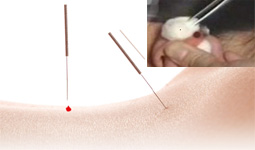|
Types
of treatment
What
can acupuncture do?
What
happens during the treatment?
What
side effects?
What
are the precautions?
ACC
treatment
First
time visit
|
| |
|
|
|
| |
Introduction
to Acupuncture |
| |
|
| |
What
is Acupuncture? |
|
| |
Acupuncture
is one of the therapeutic methods in traditional Chinese
medicine (TCM) with a history of several thousand years.
It is an ancient treatment developed under the guidance
of TCM theory. The idea of Ħ°qiĦħ (pronounced Ħ°cheeĦħ), or
vital energy, circulates the body through the pairs of channels,
meridians and acupoints, just likens water flowing in the
river, to communicate with all tissues and organs and carry
nourishment for the entire body. And the balanced flow of
qi is the vital life force for the whole system within the
body to maintain healthy, any blockages, deficiencies or
excesses will breach the balance and result in disharmony and
pain. In TCM, the aim of acupuncture is considered to stimulate
selected acupoints along the channels with certain manipulating
methods of acupuncture needles to remove any imbalances
or obstructions within the body, and eventually to encourage
the qi to flow smoothly for the prevention of disorders and
restore health.
|
|
|
| |
|
|
|
| |
Types
of Treatment |
|
|
| |
|
Acupuncture
treatment includes acupunctue needling, moxibustion, cupping, tuina, electro-acupuncture, ear acupuncture and acupressure.
Although other methods, such as infrared heating, Gua sha,
laser acupuncture etc, are also used in acupuncture treatment,
but these are the mainly used acupuncture therapeutic methods.
All acupuncture therapeutic methods can be applied separately
or combined together within each treatment, depending on the
condition being concerned.
|
|
| |
|
|
|
| |
What
can acupuncture do ? |
|
|
| |
Acupuncture
is best known in China for its high effectiveness in managing pain,
from speeding the healing time of injuries to reducing pain
and increasing mobility for people with chronic pain conditions
such as arthritis...
|
|
|
| |
|
|
|
| |
What
happens during the treatment? |
|
|
| |
|
Relatively,
the insertion of acupuncture needles is a painless procedure,
but occasionally, you may experience a small pin prick. At
Gleamy Acupuncture Centre, we use very fine, disposable, single-use
needles of between 0.20mm and 0.45mm in diameter, and the
appropriate angle and depth inserted are selected according
to the location of the acupoints which are especially important
in the process of needle insertion. Correct angle and depth
are helpful in producing desired therapeutic effects and preventing
needling accidents.
|
|
| |
Once
the needles are in the selected acupoints along particular
meridians, the acupuncturist will then apply appropriate needle
manipulations to stimulate qi and induce the arrival of qi
(called Ħ°De qiĦħ), which refers to the sensation of tingling,
electric-like weak shock, numbness, heaviness, distension
around the acupoints or travelling up and down the affected
meridians, at the same time the acupuncturist may feel heaviness
and tension beneath the needle.
The arrival of qi is directly related to the therapeutic effect.
In general, obvious and quick arrival of qi suggests good
therapeutic effects, while unclear and slow arrival of qi
shows poor therapeutic effects.
After
the qi sensation is felt, the acupuncturist will leave the
patient lying on a comfortable and natural posture which is
for prolonged retention of the needle and prevention of bending
and breaking the needle as well as fainting during acupuncture.
|
|
|
| |
Commonly, each treatment session lasts between 45minutes and
60minutes, and the number of needles used will depend on the
condition and its severity, likewise determine
the total number of treatment sessions required.
Moxibustion, electro-acupuncture, cupping and other therapeutic
methods may apply to the needles after insertion to further
stimulate the acupoints for better effects.
|
|
|
| |
What
side effects does it have? |
|
|
| |

|
Acupuncture
is relatively safe and rarely with adverse side effects when administered
by a qualified and skilled acupuncturist. Occasionally, for
a few patients, tiredness or drowsiness may occur after treatment
or existing symptoms flare up, which however is usually a
good sign, as qi clears and resettles itself.
Minor bleeding at a needle site is rare but may occur when
the needle is withdrawn. Bruising at needle site is uncommon
but may happen, especially after applying cupping therapy,
however, it will be absorbed by the body and disappear in
a few days. Other unusual accidents, such as puncturing internal
organs (e.g. the lung, pneumothorax) have been recorded. |
|
| |
What
are the precautions on the day of treatment? |
|
|
| |
To
assure a safe and relaxing experience with acupuncture treatment,
certain precautions should be aware of in order to reduce the
risk of side effects.
On
the day of acupuncture treatment, it is best to have a light
meal one hour prior to the treatment. Being overeats or over-hungry
will increase the risk of nausea or fainting.
Avoiding
alcohol, heavy physical work or strenuous exercises. Physical
strain immediately before or after acupuncture can weaken
your body.
Wearing
loose, warm and comfortable clothing that will be easily rolled
up to elbows or knees. Most commonly used acupoints are located
at limbs.
|

Avoiding overload of food

Do not take any addictive drugs |
|
| |
|
It
is very important to advise the practitioner if you are pregnant,
have a pacemaker, hepatitis, AIDS or any other infectious
conditions.
|
|
| |
|
|
|
| |
|
|
|
|

